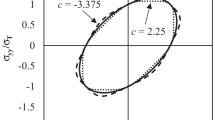Abstract
The two-level phenomenological model of the nonlinear deformation of polycrystals is extended to describe and predict the irreversible deformation of advanced shape-memory materials. The effect of various groups of residual microstresses on the deformation process is taken into account. The model is used to describe and predict deformations of shape-memory materials in cyclic thermomechanical tests, and its effectiveness is demonstrated.
Similar content being viewed by others
REFERENCES
S. B. Batdorf and B. V. Budiansky, "A mathematical theory of plasticity based on the concept of slip," NASA Tech. Report, No. 1871 (1949).
K. N. Rusinko and Ya. F. Andrusik, "Plastic deformation of a strain-hardening material under loading in the three-dimensional subspace of the five-dimensional space of plastic deviators," Izv. Ross. Akad. Nauk, Mekh. Tverd. Tela, No. 2, 92-101 (1993).
I. M. Goliboroda and K. N. Rusinko, "Description of the irreversible deformation due to martensitic transfor-mation in terms of the synthetic model," Probl. Prochn., No. 8, 68-75 (1995).
I. M. Goliboroda and K. N. Rusinko, "Derivation of a universal relation between the tangential stress shear strain intensities in describing reversible martensitic deformation within the framework of a synthetic model," J. Appl. Mech. Tech. Phys., 37, No. 3, 447-453 (1996).
I. M. Goliboroda and K. N. Rusinko, "Phenomenological model for the nonlinear deformation of polycrystalline materials produced by martensitic transformations," Zh. Tekh. Fiz., No. 11, 124-135 (1996).
I. M. Goliboroda "Description of interaction of deformation processes of defect and martensitic nature in terms of the synthetic model," Probl. Prochn., No. 6, 124-131 (1998).
I. M. Goliboroda, "Irreversible strain, elastic strain, and thermal strain of a polycrystal in reversible martensitic transformations," Mat. Met. Fiz. Mekh. Polya, 44, No. 1, 114-123 (2001).
V. A. Likhachev and V. G. Malinin, Structurally Analytical Theory of Strength [in Russian], Nauka, St. Pe-tersburg (1993).
A. A. Ilyushin, Theory of Plasticity [in Russian], Nauka, Moscow (1963).
I. M. Goliboroda, "The effect of temperature on the creep strain," Vest. L'vov. Politekh. Inst., Ser. Dinam. Proch. Mashin Pribor., No. 210, 33,34 (1987).
K. N. Rusinko and I. M. Goliboroda, "The effect of thermal hardening and aftereffect on the creep of materials with a cubic lattice," Probl. Prochn., No. 11, 58-62 (1988).
E. Orowan, "The creep of metals," J. West Scotland Iron Steel. Inst., 54, 45-59 (1946).
Yu. N. Rabotnov, Strength of Materials [in Russian], Nauka, Moscow (1962).
K. Tanaka, T. Hayashi, F. Nishimura, and H. Tobushi, "Hysteretic behavior in an Fe-Cr-Ni-Mn-Si polycrys-talline shape memory alloy during thermomechanical cyclic loading," J. Mater. Eng. Perform., 3, No. 2, 135-143 (1995).
D. B. Chernov, "Prospects of designing thermomechanical devices," in: Central Problems of Strength, Proc. XXXII Sem. (St. Petersburg, Russia, November 12-14, 1996), St. Petersburg (1997), pp. 97-105.
Author information
Authors and Affiliations
Rights and permissions
About this article
Cite this article
Goliboroda, I.M., Kuz'o, I.V. & Rusinko, K.N. Description of the Irreversible Deformation of Shape-Memory Materials in Terms of the Two-Level Phenomenological Model. Journal of Applied Mechanics and Technical Physics 45, 878–884 (2004). https://doi.org/10.1023/B:JAMT.0000046037.83191.29
Issue Date:
DOI: https://doi.org/10.1023/B:JAMT.0000046037.83191.29




